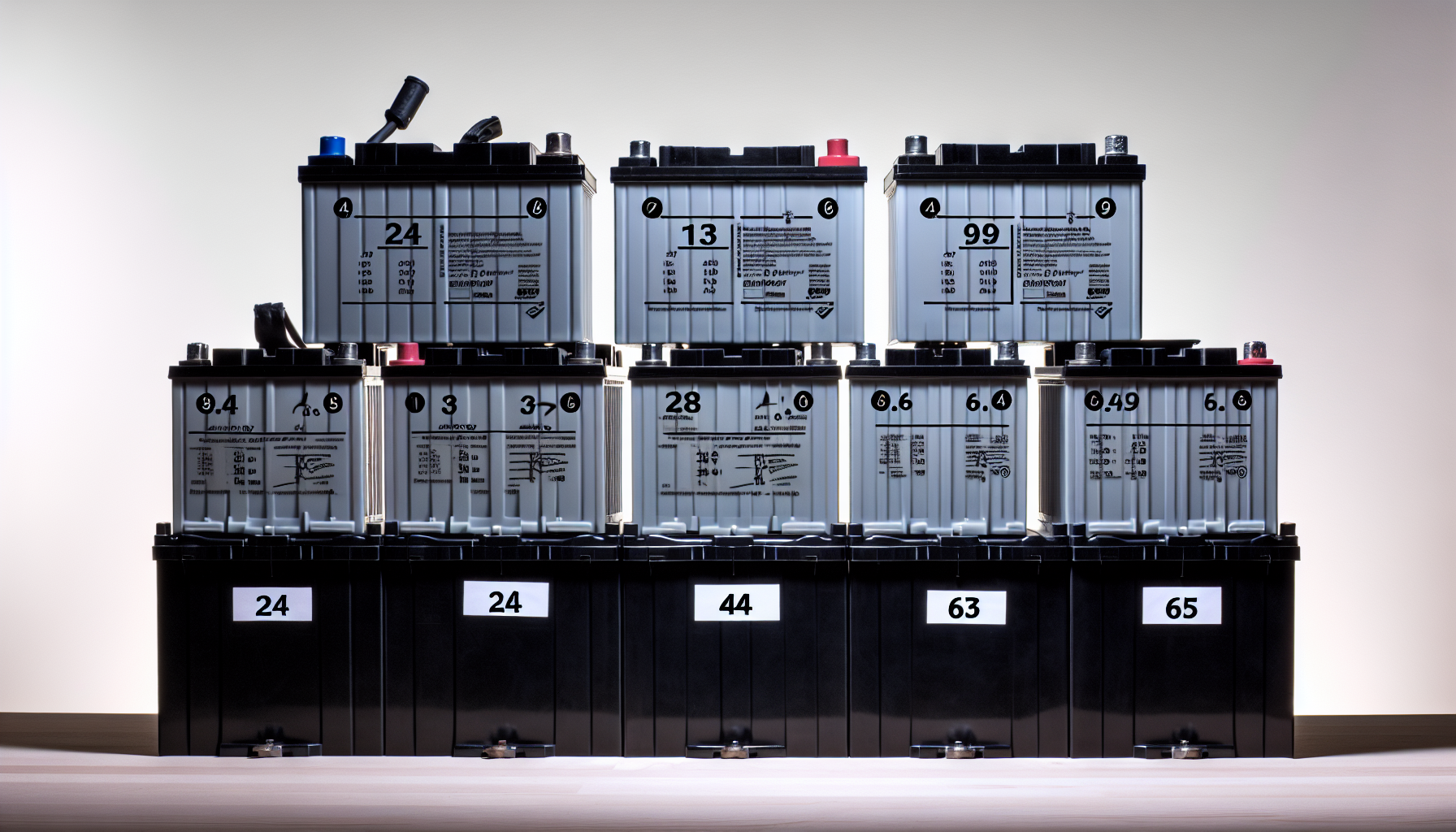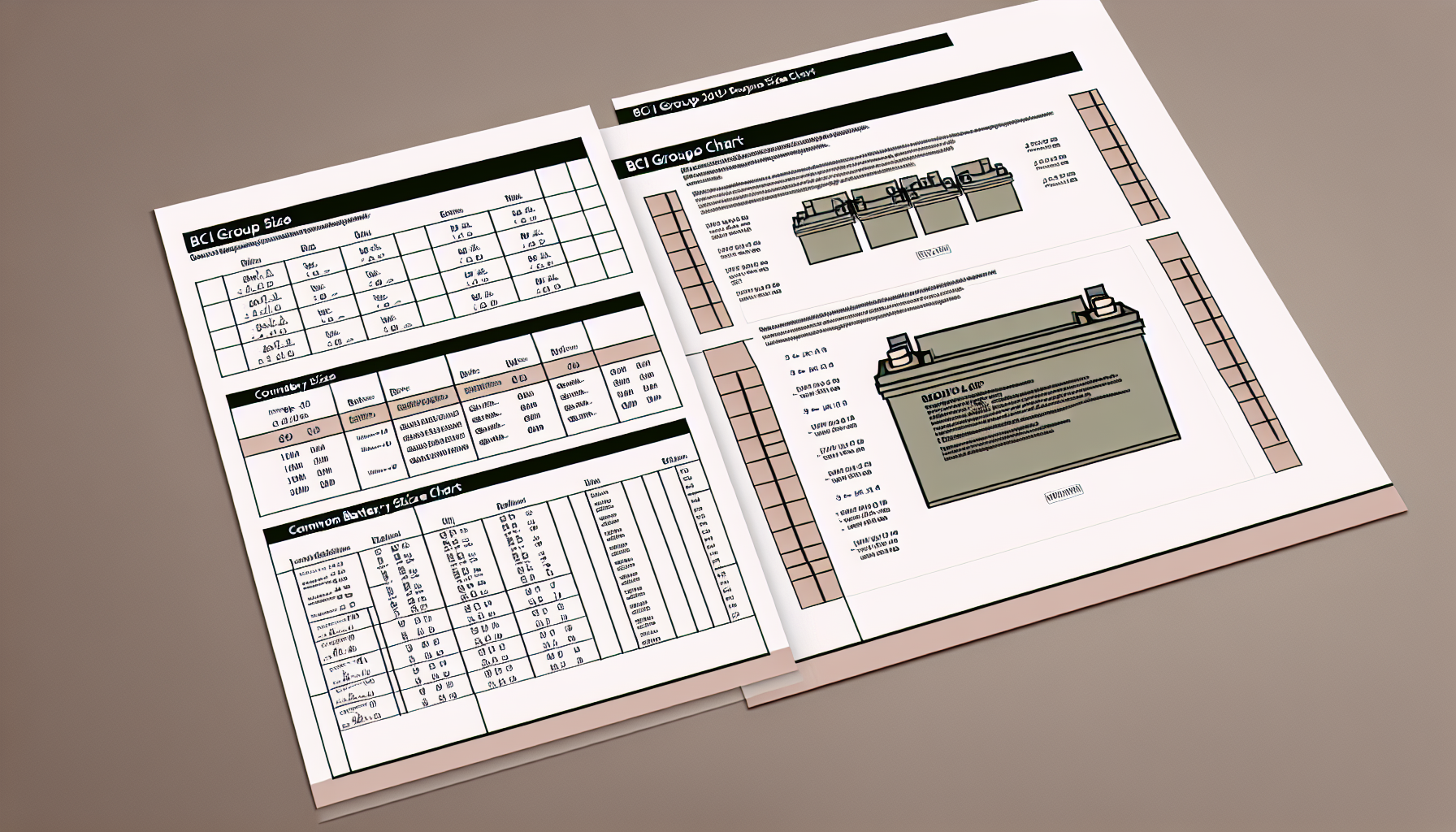
Battery Group Sizes, Chemistry, & More Explained
Wondering what is the difference in battery group sizes? Learn all about battery group sizes to understand what batteries are most compatible with your application.
Have you ever found yourself lost in the labyrinth of battery measurements and specifications when trying to replace an old battery or choose one for a new device? Whether it’s for your car, boat, golf cart, or household electronics, the right battery size can significantly impact the performance and compatibility of your device.
That’s why understanding battery sizes, chemistries, and shapes is not just handy – it’s essential!
In this post, we'll walk you through the most common battery types and sizes for various battery applications so you can shop with confidence for your next battery.
KEY TAKEAWAYS
-
The size of a battery has a significant impact on its voltage and capacity, as well as the performance of the device it powers, with larger batteries needed for more demanding applications such as vehicles.
-
Battery chemistry and cell shape are important factors to consider for optimal performance; common battery chemistries include lead acid and lithium, while cell shapes encompass cylindrical, button, and prismatic designs for different uses.
-
BCI battery sizes provide a standardized system indicating the precise physical dimensions of a battery, crucial for compatibility and safety in various applications, with a range of sizes fitting diverse power and space requirements.
Understanding Different Battery Sizes

Size plays a crucial role in battery performance. But it isn’t just about whether the battery will fit in its compartment. The size of a battery can impact its voltage and capacity, and consequently, the performance of the device it powers.
You are probably familiar with the most common batteries for many different types of household appliances and devices, such as A, AA, AAA, D and E.
However, when you need to power larger devices or vehicles, you’ll need to consider one of the larger battery groups, such as groups 24, 27, 31, and so on.
Suppose you need a replacement battery. The process is more complex than merely selecting a same-sized battery from the shelf. Before disposing of the old battery, it’s important to check its:
-
Voltage
-
Capacity
-
Terminal
-
Chemistry
-
Dimensions
This information will be helpful when selecting a replacement battery. This step guarantees that your new battery aligns with your device and performs at its best. Putting the wrong battery into a device can damage both the battery and the device itself.
If you're replacing batteries in a used device, an important step would be to check the device itself for indications of what battery size should be used. Sometimes when people are in a bind they will put whatever battery they have on hand or what is the cheapest replacement battery rather than putting in the proper one.
And it’s not just about the physical dimensions. You also need to match the voltage and capacity. A higher capacity battery will last longer before needing a recharge, while the voltage needs to match your device’s requirements to avoid damaging it or hampering its performance.
Navigating through this myriad of battery measurements can be daunting. A good starting point is understanding what the difference in battery group sizes are for various applications, including:
-
Household electronics
-
Automotive
-
RV
-
Marine
-
Golf cart applications
Let’s delve into these in the following sections.
Household Battery Sizes
You’re probably more familiar with household battery sizes than you realize. They’re the ones you pop into your remote control, wall clock or digital camera. Common sizes include:
-
AA 0.53 in diameter and 1.94 in height
-
AAA 0.41 in diameter and 1.75 in height
-
C 1.03 in diameter and 1.97 in height
-
D 1.3 in diameter and 2.42 in height
-
9-Volt E (rectangular) 1.9 in x 1 in x 0.6 in
Understanding their typical applications is equally important as knowing the sizes. AA batteries, for instance, are quite versatile. They power a range of devices, including:
-
Wireless doorbells
-
Remote controls
-
Digital cameras
-
Wall clocks
-
TV remotes
-
RC toy cars
-
Flashlights
-
Motion detectors
-
Carbon monoxide detectors
-
Smoke detectors
-
Clocks
-
Thermostats
-
Toys
-
Photo equipment
-
Calculators
-
Radios
No wonder they’re so common!
Automotive and RV Battery Sizes

Moving on to larger batteries, let’s talk about automotive and RV battery sizes. These are a bit more complex than household batteries because the size varies based on the manufacturer’s recommendation.
Passenger vehicles and RVs commonly come in sizes such as:
-
Group 24
-
Group 27
-
Group 34
-
Group 35
-
Group 48
-
Group 49
-
Group 65
-
Group 78
These sizes are widely used and provide options for various vehicle needs.
With so many options, how do you choose the right one? An RV battery size chart can be a lifesaver here. It catalogs the various available battery group sizes for RVs, assisting in selecting the appropriate battery, and simplifying the process of narrowing down options. It’s like having a cheat sheet for battery group sizes!
However, equal size doesn’t necessarily make two batteries interchangeable. Always consult the manufacturer’s recommendation to ensure you pick the right battery size for your vehicle. A mismatch can result in poor performance or even damage your vehicle’s electrical system.
Boat and Marine Battery Sizes
Next, we navigate the waters of boat and marine battery sizes. These are determined based on the group size, which is a result of the battery’s overall dimensions and capacity. When determining the best boat power system setup, you'll want to evaluate what the current battery tray size is and/or what modifications you may need to make if you want to change the voltage and/or capacity of the power system.
Factors such as the vessel’s performance requirements, physical dimensions, weight and electrical capacity influence the appropriate battery size.
Typically, boat and marine batteries encompass Group 24, Group 27, and Group 31. These sizes are selected according to the capacity and dimensions that are suitable for a range of marine applications, as well as the required battery voltage.
For instance, a group 31 battery, measuring 12.8 inches in length, 6.8 inches in width, and 9.3 inches in height, is slightly larger than a group 27 battery. This ensures adequate power delivery and compatibility within marine systems.
Choosing a battery for your boat or marine vessel requires considering the specific power requirements of the vessel. The wrong battery size can affect the performance and even the safety of your vessel. So, always consult the manufacturer’s recommendations or a professional before making a decision.
SHOP OUR PROCONNECT SERIES LITHIUM BATTERIES FOR MARINE APPLICATIONS
Golf Cart Battery Sizes
These are unique and typically preceded by “GC,” indicating a specific group size designed for golf cart applications. The predominant battery size utilized for golf carts is the GC2. However, alternative battery sizes for golf carts include 6 Volt and 12 Volt battery sizes where multiple batteries can be connected in series to add the voltage of the batteries to reach the system requirements.
For example, if you operated a 48V golf cart and you wanted to use 6V batteries you would need 8 batteries connected in series to take 8V x 6 batteries = 48V of power. Likewise, you could use 4 x 12V batteries for the same 48-volt system.
SHOP NOW: We offer the best 48 Volt golf cart battery on the market so you only need to drop one or more of these into your golf cart connected in parallel to meet your system requirements.
As with other battery types, taking into account the manufacturer’s recommendations is vital when replacing a golf cart battery. Remember, the right battery will ensure optimal performance and longevity of your golf cart.
Battery Chemistry and Cell Shape

After discussing what battery group sizes are, we turn our attention to another important factor: battery chemistry and cell shape. These factors play a significant role in a battery’s performance and are often dictated by the device’s power needs and space constraints.
The TWO most common battery chemistry types are lead-acid and lithium, each with its distinct characteristics and advantages. Battery cells, on the other hand, come in three common shapes: cylindrical, button, and prismatic.
Each of these shapes is suitable for different applications. For instance, cylindrical batteries such as AA, AAA, C, and D are used in household devices, while button cells power small electronics like watches and hearing aids.
Prismatic cells, due to their space-efficient shape and larger size, are typically used in larger battery packs for electric vehicles, mobile phones, and laptops.
Comprehending the battery’s chemistry and cell shape is as crucial as being familiar with its size. It helps ensure you choose a battery that delivers optimal performance for your device. Let’s explore these aspects in more detail.
NOTE: All of our Enduro Power Batteries lithium batteries are built using prismatic technology which allows us to fit more power into less space, thus you will have 25% less case size for the same amount of power you can buy from our competitors. A smaller battery size means you can fit more batteries to have a high capacity, or you can use fewer batteries and save the space and weight in your battery compartment.
Lead Acid Batteries
Lead Acid Batteries are the traditional choice for many applications. They are characterized by:
-
High starting current
-
Low depth of discharge (cannot use more than 50% of the battery capacity)
-
Acid-resistant outer skin
-
Two lead plates as electrodes
-
Use of sulfuric acid as the electrolyte
However, they have a lower energy density compared to lithium-ion batteries, ranging between 50-90 Wh/L compared to 125-600+ Wh/L for lithium-ion.
The lifespan of lead-acid batteries depends on the type. Flooded or Wet-Cell batteries typically last for approximately 500 cycles or 2-4 years. In contrast, AGM and Gel batteries can last between 600 and 1200 cycles or 3-8 years, contingent upon the quality of the battery.
Lead-acid batteries, including automotive batteries, are commonly used in:
-
Automobiles
-
Uninterruptible power supplies (UPS)
-
Marine applications
-
Secondary batteries for delivering higher surge currents
Despite their lower energy density and shorter lifespan, they remain a popular choice due to their affordability and availability.
Lithium Batteries
Now let’s talk about lithium batteries. They are known for their high reliability, long lifespan, reduced mass, compact dimensions and high energy density. These rechargeable batteries operate within an increased voltage range and consist of essential elements such as a positive electrode, negative electrode, electrolyte, separator, casing, and electrode lead.
Despite their advantages, lithium batteries come with a higher price tag. So if you are looking for the cheapest battery chemistry type, lithium is not the way to go. But if you want the best long-term value, in addition to the other benefits of switching to lithium batteries, then lithium is your best option.
A lithium battery that has a high energy density compared to other types of batteries makes it a popular choice for many applications.
Whether you choose a lead-acid or a lithium battery depends on your specific needs and the device you intend to power. Of course, the price also comes into consideration. But when it comes to batteries and the devices that they power, we recommend that you consider investing in the best value, rather than the cheapest option.
Battery Group Sizes Explained
| BATTERY GROUP SIZE | L x W x H (cm) | L x W x H (in) |
| GROUP 24 | 26 x 17.3 x 22.5 | 10.25 x 6.82 x 8.86 |
| GROUP 27 | 30.6 x 17.3 x 22.5 | 12.07 x 6.82 x 8.88 |
| GROUP 31 | 33 x 17.3 x 24 | 13 x 6.82 x 9.44 |
| GROUP 34 | 26 x 17.3 x 20 | 10.25 x 6.82 x 7.88 |
| GROUP 35 | 23 x 17.5 x 22.5 | 9.07 x 6.88 x 8.89 |
| GROUP 51 | 23.8 x 12.9 x 22.3 | 9.38 x 5.07 x 8.82 |
| GROUP 65 | 30.6 x 19 x 19.2 | 12.07 x 7.5 x 7.57 |
| GROUP 78 | 26 x 17.9 x 19.6 | 10.25 x 7.07 x 7.32 |
Having explained batteries by size, chemistry, and cell shape, we now examine battery group sizes. These specific designations, published by the Battery Council International (BCI), indicate the precise physical dimensions of a battery.
These standard group sizes were established to make it easier for you to simply swap out an old battery with a drop-in replacement battery of the same dimensions so you don't have to try and compare apples to oranges when it comes to replacing your batteries.
Group sizes play a crucial role in ensuring compatibility in various battery applications, guaranteeing that the battery dimensions and terminal placement align with the available space in the application, enabling a secure fit and preventing movement.
The BCI battery size chart is a handy tool when selecting a battery. It helps ascertain the physical dimensions of the battery case, aiding in the selection of a battery with the appropriate case size for specific applications. Some examples of BCI group sizes include:
-
Group 24
-
Group 27
-
Group 31
-
8D
These group sizes establish a general standard for battery sizes across different applications.
Comprehending battery group sizes is vital not only for compatibility but also for safety. Using a battery that doesn’t fit properly in its battery compartments can cause it to move around, possibly leading to leaks, short circuits, or other damage.
So, it’s always essential to ensure you’re choosing the right group size for the battery compartments intended.
BCI Group Size Chart and Compatibility

The BCI Group Size Chart presents a detailed list of the most frequently used BCI battery sizes. Here, you can find detailed information, including the length, width, and height for each group size.
What if you wish to replace your old battery with one from a different group size? It’s doable but necessitates careful consideration. It’s crucial to seek advice from professionals to verify that the new battery is a safe and compatible choice. Inappropriate substitution could lead to harm, accidents, or serious repercussions.
In some cases, batteries from different BCI group sizes can be used interchangeably, provided that the new battery meets the necessary dimensions, and possesses equivalent or superior electrical characteristics to the old battery.
However, the golden rule is always to consult the manufacturer’s recommendation or a professional before making a switch.
Interpreting BCI Group Sizes
Deciphering BCI group sizes is pivotal to selecting the appropriate battery for your needs. The group sizes encompass not only the physical dimensions of the battery but also the terminal orientation and hold-down type, which are crucial for proper fit and function.
Understanding the differences between various group sizes can also be valuable. When replacing the battery independently, it is important to consider the following:
-
The actual battery size
-
Measure the battery compartment
-
Check the battery orientation
-
Terminal types
-
Hold-down system
By taking the time to interpret these group sizes accurately, you can ensure you choose the right battery for your system.
Choosing the Right Size Battery for Your System

Several key factors come into play when selecting the appropriate battery size for your system. Apart from the form factor, voltage, and capacity, you also need to consider your budget and power requirements. One way to calculate your power requirements is by using the formula: Power (watts) = Voltage (volts) x Current (amps).
Differentiating between primary and secondary battery types, evaluating energy versus power requirements, ensuring voltage compatibility, and assessing temperature range, and capacity are all primary considerations when selecting the appropriate battery size for a system.
The form factor of a battery pertains to its physical dimensions and configuration, typically in conjunction with its electrical specifications. While the form factor itself does not directly determine the compatibility of a battery with a system, verifying that the battery’s form factor aligns with the system’s size and shape requirements is crucial.
Selecting the correct battery size for your system is imperative to guarantee the device’s optimal performance and lifespan. Remember, each device has its unique power requirements and space constraints, so what works for one might not work for another. Always consult the manufacturer’s recommendations or a professional to ensure you’re making the right choice.
Summary
Understanding battery sizes, chemistries, and shapes is vital to ensure optimal performance and longevity of your devices. Whether it’s for household electronics, vehicles, boats, or golf carts, choosing the right battery involves considering the form factor, voltage, capacity, and group size.
Also, always consult the manufacturer’s recommendations or a professional to ensure you’re making the right choice. Remember, the right battery can significantly enhance your device’s performance and lifespan!
|
NEED MORE ASSISTANCE PLANNING YOUR POWER SETUP? GIVE US A CALL AT 303-968-1366 AND OUR TEAM WILL HELP YOU GET STARTED! |